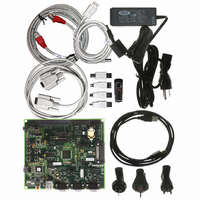M52259EVB Freescale Semiconductor, M52259EVB Datasheet - Page 12

M52259EVB
Manufacturer Part Number
M52259EVB
Description
BOARD EVAL FOR 52259 COLDFIRE V2
Manufacturer
Freescale Semiconductor
Series
ColdFire®r
Type
MCUr
Datasheet
1.M52259EVB.pdf
(46 pages)
Specifications of M52259EVB
Contents
Board, Cables, Documentation, DVD, Flash Drive and Power Supply
Processor To Be Evaluated
MCF52259
Data Bus Width
32 bit
Interface Type
RS-232, Ethernet, USB
Silicon Manufacturer
Freescale
Core Architecture
Coldfire
Core Sub-architecture
Coldfire V2
Silicon Core Number
MCF52
Silicon Family Name
MCF5225x
Peak Reflow Compatible (260 C)
Yes
Rohs Compliant
Yes
For Use With/related Products
MCF52259
Lead Free Status / RoHS Status
Lead free / RoHS Compliant
The ADC can be configured to perform a single scan and halt, a scan when triggered, or a programmed scan sequence repeatedly
until manually stopped.
The ADC can be configured for sequential or simultaneous conversion. When configured for sequential conversions, up to eight
channels can be sampled and stored in any order specified by the channel list register. Both ADCs may be required during a
scan, depending on the inputs to be sampled.
During a simultaneous conversion, both S/H circuits are used to capture two different channels at the same time. This
configuration requires that a single channel may not be sampled by both S/H circuits simultaneously.
Optional interrupts can be generated at the end of the scan sequence if a channel is out of range (measures below the low
threshold limit or above the high threshold limit set in the limit registers) or at several different zero crossing conditions.
1.2.16
There are four independent, DMA transfer capable 32-bit timers (DTIM0, DTIM1, DTIM2, and DTIM3) on the device. Each
module incorporates a 32-bit timer with a separate register set for configuration and control. The timers can be configured to
operate from the system clock or from an external clock source using one of the DTINn signals. If the system clock is selected,
it can be divided by 16 or 1. The input clock is further divided by a user-programmable 8-bit prescaler that clocks the actual
timer counter register (TCRn). Each of these timers can be configured for input capture or reference (output) compare mode.
Timer events may optionally cause interrupt requests or DMA transfers.
1.2.17
The general purpose timer (GPT) is a four-channel timer module consisting of a 16-bit programmable counter driven by a
seven-stage programmable prescaler. Each of the four channels can be configured for input capture or output compare.
Additionally, channel three, can be configured as a pulse accumulator.
A timer overflow function allows software to extend the timing capability of the system beyond the 16-bit range of the counter.
The input capture and output compare functions allow simultaneous input waveform measurements and output waveform
generation. The input capture function can capture the time of a selected transition edge. The output compare function can
generate output waveforms and timer software delays. The 16-bit pulse accumulator can operate as a simple event counter or a
gated time accumulator.
1.2.18
The two periodic interrupt timers (PIT0 and PIT1) are 16-bit timers that provide interrupts at regular intervals with minimal
processor intervention. Each timer can count down from the value written in its PIT modulus register or it can be a free-running
down-counter.
1.2.19
The Real-Time Clock (RTC) module maintains the system (time-of-day) clock and provides stopwatch, alarm, and interrupt
functions. It includes full clock features: seconds, minutes, hours, days and supports a host of time-of-day interrupt functions
along with an alarm interrupt.
1.2.20
The device has an 8-channel, 8-bit PWM timer. Each channel has a programmable period and duty cycle as well as a dedicated
counter. Each of the modulators can create independent continuous waveforms with software-selectable duty rates from 0% to
100%. The timer supports PCM mode, which results in superior signal quality when compared to that of a conventional PWM.
The PWM outputs have programmable polarity, and can be programmed as left aligned outputs or center aligned outputs. For
Freescale Semiconductor
DMA Timers (DTIM0–DTIM3)
General Purpose Timer (GPT)
Periodic Interrupt Timers (PIT0 and PIT1)
Real-Time Clock (RTC)
Pulse-Width Modulation (PWM) Timers
MCF52259 ColdFire Microcontroller, Rev. 4
Family Configurations
12










